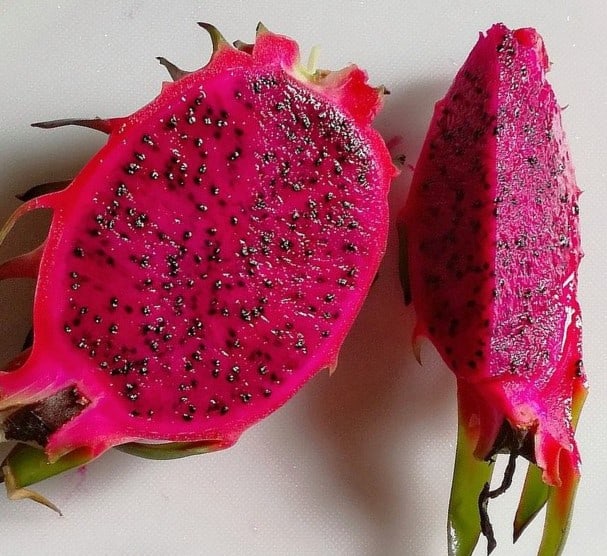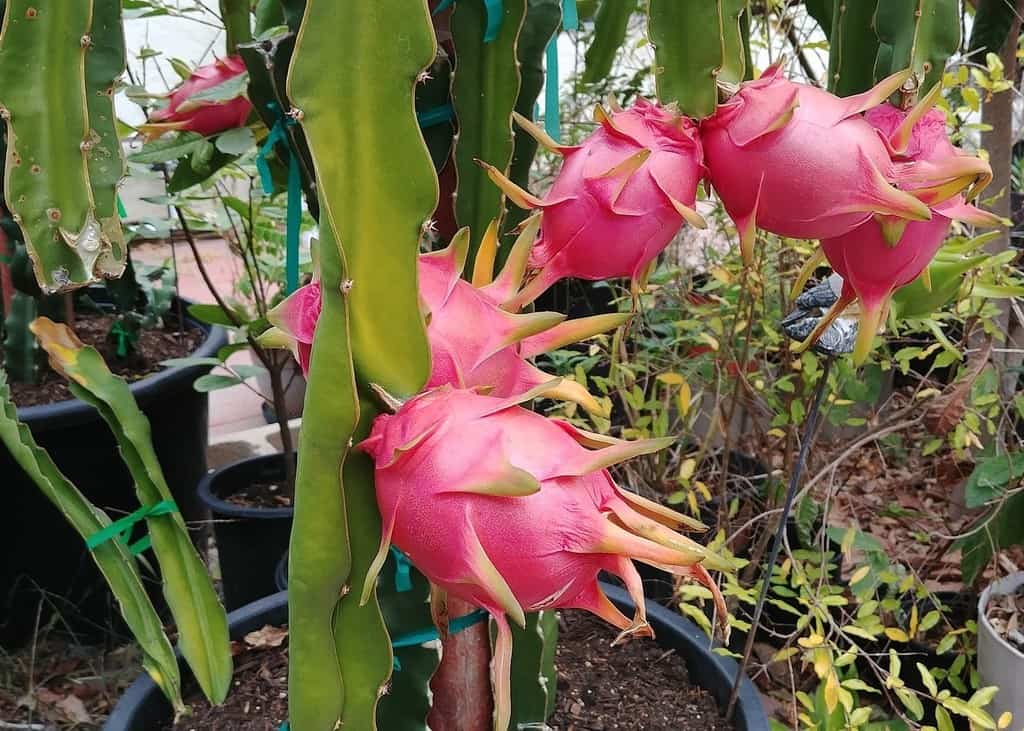I first got acquainted with the amazing superfood, Dragonfruit, completely by accident when I moved into a house that had a strange looking cactus growing up the wall. Yes, that’s right, a cactus that grows like a vine, clinging onto the wall with its roots. Every time I checked, it seemed to be noticeably taller than the last time.
At first, I didn’t really pay much attention. However, when the fast-growing cactus had grown all the way up the wall and through the tiles of the roof, I was forced to take note. When a massive 12-inch long and 8-inch wide flower had appeared, I was not only paying attention but became instantly captivated. A quick Google search led me to believe that what I had, growing in my yard was, in fact, a dragonfruit cactus.
Like many westerners, I had never eaten a dragonfruit despite its popularity in Asian countries. Nor had I even heard of it. However, with the West learning about the amazing properties of the fruit, that situation is starting to change. After reading about how tasty they are and their awesome health benefits, I couldn’t wait for the fruit to appear.
Alas, the plant never did fruit. Instead, the flower simply fell off. You see, some varieties of dragonfruit are not self-fertile. For these, it is necessary to have a different variety within ten meters for pollination and hence fruiting to occur. It turns out that the dragonfruit plant is remarkably easy to grow, that is, as long as you don’t make a few common mistakes. More on that later.
Contents
How does a Dragonfruit look?
If you are ever in a fruit market and you see dragonfruit being sold, do yourself a favor and pick one up. On the outside, it looks strange, almost like a dragons egg or a flaming ball of fire with its brightly colored scales of green and red. On the inside, it’s even stranger, often coming in psychedelic neon shades of purple and pink or bright white, speckled with small black seeds.

The Taste of the Dragon Fruit
The taste of the fruit depends on which variety you get. The white-fleshed varieties are usually bland with a slightly sweet and earthy flavor. However, most purple and pink-fleshed varieties range from somewhat sweet to very sweet. It’s got a taste of pear and watermelon, a slight tartness and a crunch reminiscent of kiwi fruit. Then, there is the king, measuring as high as 18 on the Brix sweetness scale. This is the yellow-skinned, white-fleshed variety, which though smaller than the others, is super-sweet. Similar to a giant litchi.
Dragonfruit is incredibly easy to eat. No thick skins or hard pits here. The seeds are soft with a pleasant crunch. The thick skin peels away from the flesh with little effort. Simply slice the fruit up and serve.
Dragonfruit plant varieties
Voodoo Child, Natural Mystic, Neon, Purple Haze, and Physical Graffiti. No, these are not varieties of an illegal herb, but rather varieties of the dragonfruit plant. Apart from the three well-known varieties of dragonfruit, there are also many strains or cultivars which are grown from cuttings and are selected for specific characteristics such as their sweet fruit or hardiness. One of the most impressive varieties is the Bruni. With its beautiful pink flowers, and it’s super-sweet fruit clocking in at a whopping 21.3 on the Brix scale, this heavy-producer would make a welcome addition to any garden.

Health Benefits of Dragonfruit
If you are reading this, there is a good chance you already know about some of the dragonfruit’s amazing health benefits (along with its great taste). However, I feel it is worth repeating: dragon fruit is a true superfood.
- It’s low in Calories. At only 60 cal. per 100 grams, it would be pretty difficult to get fat from eating dragonfruit.
- A study published in the Journal of Pharmacognosy Research found dragon fruit to lower bad cholesterol while at the same time increasing the good cholesterol. Dragon fruit is also a great source of monounsaturated fats while the seeds are high in heart-healthy omega 3 and 6.
- Dragon fruit contains a host of anti-oxidants such as phytoalbumin, carotenoids, betalains, and vitamin C. This means that it may have cancer-fighting properties and may even slow the aging properties. Plus, it contains lycopene (also found in tomatoes), which has been shown in several studies to combat cancer.
- Research has shown dragon fruit to benefit obese mice by reducing the risk as well as the symptoms of diabetes. It also contains oligosaccharides which act as in the gut as prebiotics, keeping you healthier overall.
- Being high in vitamin C means it will also boost your immune system and keep those pesky colds and flu’s away.
Growing the Dragonfruit Plant

Okay, so it looks great in a salad. It fights cancer, heart disease, diabetes, and aging, but it’s so expensive, you might say. With a price that is exponentially more than most of the common produce found in the local fruit market, it would be difficult to eat dragonfruit every day. That is unless you grow it yourself. Dragon fruit plants require little maintenance and are therefore great for those of us who like to travel. There are, however, a few things to keep in mind before you purchase your dragonfruit plants.
Firstly, make sure your dragonfruit plant is self-fertile. Many varieties, most of the purple-fleshed ones, in fact, are not self-fertile. This means you will need to grow another variety which flowers at the same time within a ten-meter radius if you want your plant to bear fruit. One great idea is to grow a few different varieties in the same large container. This brings me to my next point.
Make sure you buy your plants from a reputable dealer. Your plants should always be grown from cuttings and not seeds as plants grown from seeds might have unwanted characteristics.
I already mentioned containers. Dragon fruit plants love containers. Choose one that is at least 24 inches wide and make sure the soil is well draining as cacti are prone to rot. Being a vine, they will also need a stake or a fence on which to climb. At the same time, being a fast growing cactus, they require a yearly pruning… I said little maintenance, not no maintenance.
From Seed to Stomach
So you grew your dragonfruit in the backyard garden. Like Jack and the Beanstalk you saw it sprout up and crash through the tiles of the roof. You wait patiently until, one day, the first dragonfruit appears at the top end of the dragonfruit plant. It was all worth it. Now the only thing that’s left is to enjoy the fruits of your labor. If you travel a lot, make sure you know when your plant will fruit so that you will be home to enjoy it!

Have you ever grown a dragonfruit plant and do you like the taste of Dragonfruit? Comment below with tips and questions!
This Dragonfruit Blog Post is a Guest-written Article
by Marco da Silva (website)



What variety is self-fertile?
Hi Marlene.
Some varieties that I know to be self-fertile are Bruni, American Beauty and Voodoo Child. It is important to do your research before buying any variety. Some argue that self fertile varieties give larger fruit when pollinated by another variety so it might be a good idea to get more than one variety.
Happy Gardening.